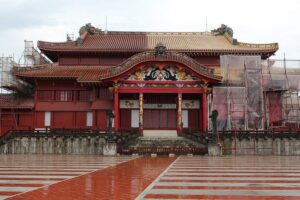Soft Fist Training is based on the internal martial arts as practiced in the Wudang Mountain region of Northern China (similar to the techniques taught to Seiyu Oyata by Okinawan Bushi Wakinaguri). The techniques are a series of movements which are the advanced level of RyukyuTe training.
Internal or Soft hand of RyukyuTe – with Five Element principles. From my training in the Soft Fist techniques from Oyata Sensei (along with years of practice and research). I have define the Soft Fist techniques with these five elements: (each one a progression of the others – Ku being the mosted advanced)
WIND: (1) Soft Wind Palm– spiral energy from the ground – the smaller the spiral the lighter the touch – winding up of the strings or tendons (1a) Killing Wind Palm – stretch the strings or tendons
EARTH: (2) Thunder Fist – Backfist power with multi strikes – 4 strings /strikes of the back hand in one technique
FIRE: (3) Deceptive; needle and cotton Focus of Ki – one finger attacks
WATER: (4) Rain: focus of Ki with five finger attacks
KUU: (5) Sun – or Heaven: – the mind and body are loose but ready – the “form from no form”, and the “strategy of no strategy”. With no strategy, your mind can be clear and still as a lake, free to spontaneously respond to your opponents’ actions. Contains instantaneous counters, without blocks or grabs, which would be an unnecessary step for the counter-attack.
Oyata Sensei, had 2 major instructors: Uhugushiku was an Okinawan Bushi (warrior) ; he was a Gate Guard for the Royal Family. Uhugushiku passed on his knowledge of Tuite to Oyata. Oyata also learned from; Wakinaguri was of Chinese descent and also an Okinawan Bushi. Wakinaguri taught Oyata his family’s style of martial arts (to-te or “Chinese Hand”) which included technique of “Soft Fist” with pressure-point strikes. Since neither Uhugushiku nor Wakinaguri had children to whom to pass on their arts, Oyata became the inheritor of both. Oyata was very closed with his teachings of “Soft Fist” techniques.
Five Element Theory of RyukyuTe — GODAI – (Japanese Philosophy of the Five Elements)
五大 GODAI means Five Great, with the elements of Earth, Water, Fire, Wind and Void.
- 地 Earth CHI – The earth, ground. Resistance to movements. Stability.
- 水 – Water – SUI – Fluid, Liquid. Flexibility. Adaptability.
- 火 – Fire – KA – Power, Passion, Motivation.
- 風 – Wind – FUU – Growth, Expansion, Freedom.
- 空 – Void – KUU- Also means Sky. Unlimited space, Spirituality, Creativity.
This philosophy of five elements originated from Buddhism, different from the Chinese theory of five elements. GODAI is used in Japanese architecture and Zen gardens, as well as in martial arts training.
One of the most interesting elements is 空 – Void, Sky. It is the highest of the five. It is the empty space, stillness, silence. It is the door to connect to our unlimited power, which you may call it higher-self or Heaven. We connect to this essence of power in our everyday lives, when our mind is still and silent, through meditations, rituals, and practices.
For our everyday lives, we need to have all five elements in balance. If we have an excess, it will become a negative element and would cause unbalance in physical form. For example, stability becomes stubbornness, Flexibility becomes indecisiveness, Too much fire can turn into anger.
Note: Ryukyute Motobu Sanchin is the Required Kata Shinan Training in Godai
Note this video shows some elements of “Soft Hand / Fist” principles:





